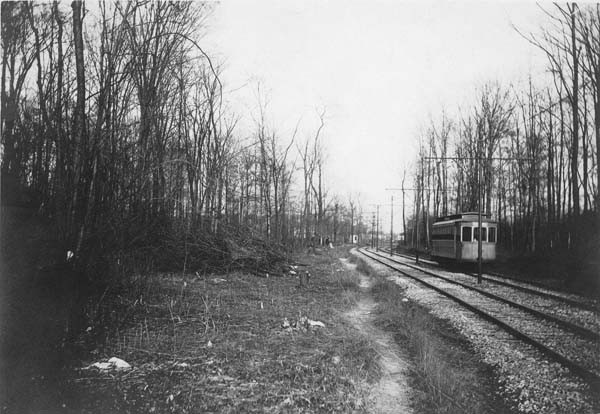
Many residents of Shaker Heights know that the Van Sweringen brothers built the Shaker Rapid Transit in the early twentieth century to provide Shaker residents with quick and efficient public transportation service between their suburb and downtown Cleveland. Probably considerably fewer, however, know that more than a decade before the Shaker Rapid ran its first trains from Shaker to downtown Cleveland on April 20, 1920, the Van Sweringens had already created a public transportation system for Shaker Heights. That public transportation system, which also transported Shaker residents to and from downtown Cleveland, was the Shaker Lakes trolley line.
The story of the Shaker Lakes trolley line is the story of how the Van Sweringen brothers, unlike other Cleveland area developers of the early twentieth century, were able to successfully develop the 1300 acres of land in East Cleveland, Cleveland Heights, and Shaker Heights that was formerly the site of a colony of the United Society of Believers in Christ's Second Appearance, more commonly known as the Shakers. In 1889, the Shakers dissolved this colony and the land was sold. During the period 1892-1906, several local and out-of-state groups attempted to develop the land for single-family residential subdivisions. All failed, except the Van Sweringen brothers who succeeded largely because they were able to build a transportation system along Fairmount Boulevard that persuaded wealthy Clevelanders to move from Cleveland to Shaker Heights.
The story of the Van Sweringens' first transportation system begins In 1906, when the brothers, following the development model earlier employed by Patrick Calhoun in the latter's development of Euclid Heights, persuaded the Cleveland Electric Railway Company to extend its Euclid Heights trolley line along Fairmount Boulevard from Cedar Road to Lee Road, a distance of approximately two miles. In this venture, the Van Sweringens also employed the F.A. Pease Engineering Company to design an extension of Fairmount Boulevard. Three years earlier, in 1903, the Pease firm had designed the conversion of Fairmount Boulevard in Euclid Heights from a single lane dirt road into a grassy divided highway, making it, according to several sources, the first such highway in the United States.
By 1907, the Van Sweringens had completed construction of the Fairmount Boulevard extension and the Cleveland Electric Railway had laid trolley tracks on the Boulevard all the way to Lee Road. Just one year later, the Shaker Heights Land Improvement Company, which was controlled by the Van Sweringens, was already building and selling upper class housing on Fairmount Boulevard.
The Shaker Heights trolley line was the the fastest public transportation route from Shaker Heights to downtown Cleveland from 1907 until 1920. This was a critical period for the development of Shaker Heights. During this time, the garden suburb grew from a population of less than 200 to one of approximately 1,500 residents--a more than 700 percent increase in population.
For residents who boarded the trolley at its terminus at Fairmount Boulevard and Lee Road, the trolley trip to downtown Cleveland took an average of 45 minutes. When the Shaker Rapid opened in 1920, the trip to downtown Cleveland was significantly reduced. When the line was completed, travel time was only about fifteen minutes. While the Shaker Rapid supplanted the Shaker Lakes Line as the quickest public transportation route to downtown Cleveland, Shaker Heights would not have developed when it did and as it did were it not the vision of the Van Sweringens and the Shaker Lakes trolley line.
Audio
Images






